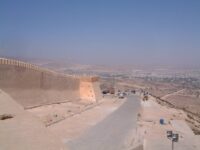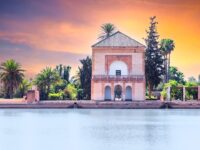History of Agadir

Agadir (“fortified granary” in Berber) is a city in southwestern Morocco, located on the Atlantic coast 508 km south of Casablanca, in the Souss region. Agadir is the prefecture of the administrative region Souss-Massa-Draa.
The origins of Agadir are still very obscure:
Some authors have identified it with the ancient port of Rusaddir, cited by Polybius, and that the Carthaginian admiral Hannon may have visited during his famous journey.
In medieval times, Agadir was a small town of little notoriety, Agadir el-arba`, the outlet to the sea of the great city of Souss, Taroudant.
It was in 1505 that a Portuguese gentleman, Joâo Lopes de Sequeira, acting on his own initiative, undertook the construction of a fortress called Santa Cruz de Cap de Gué which encompassed a spring gushing near the sea. This small fortress was not located on the site of present-day Agadir but a little further north among the Ait Founti. It was also known as Santa Cruz de Narba or Angoa de Narba, this last toponym being an allusion to the spring that the fortress contained.
In 1513, Santa Cruz de Cap de Gué was sold to the king of Portugal and the first governor Don Francisco de Castro (1513-1521) completed the fortification work and brought the surrounding area under his authority, developing at the same time commercial relations with the natives. At that time, the port was frequented by Spanish, Genoese and French traders who paid fees to the Portuguese authorities. As early as 1531, Mohammed Ech Cheikh set up a military base in Tamraght, 12 km north of the place, to organize the blockade of the fortress. The fortress was almost stormed in February 1533 after the governor’s assassination, but Simao Gonçalves managed to seize the rocky outcrop that dominated Santa Cruz de Cap de Gué, which caused the sheriff to retreat. A new attempt was made in September 1540, without any further success, and finally, the place fell into the hands of Mohammed Ech Sheikh, after fierce fighting, on March 12, 1541.
The port was then developed to serve as an outlet to the plain of Souss and even Sudan. Sheets were unloaded there while sugar cane, dates, wax, raw hides, gold etc. were exported. Towards the middle of the 17th century, sugar cane cultivation declined as a result of competition from the West Indies and Brazil on the European market.
In 1746, the Dutch established a trading post at the foot of the kasbah under the authority of the sultan. After a long period of prosperity, Agadir declined from 1760 onwards, due to the pre-eminence granted by the Sultan to the competing port of Essaouira Sidi Mohammed ben Abdellah.
The traveler Cochelet, who visited the city in 1819, counted only a dozen houses still standing.
At the beginning of our century, Agadir was the scene of an episode in the Franco-German rivalry over Morocco. The sending by Germany, in July 1911, of the warship Panther almost provoked the war between the two countries.
In 1913, the city had less than a thousand inhabitants. After 1920, under the French protectorate, a modern port was built and the city experienced its first boom.
Around 1930, Agadir was an important stopover for the Aéropostale, where Saint-Exupéry and Mermoz made stopovers.
In the 1950s, the city, very dynamic, began to open up to tourism.
On February 29, 1960, Agadir suffered a violent seismic tremor (magnitude 6.7) that destroyed almost the entire city and caused the death of between 15,000 and 20,000 of its inhabitants.
Video
The tourist vocation of Agadir
“If fate has decided the destruction of Agadir, its reconstruction depends on our faith and our will.
This sentence pronounced by our late liberator S.M. Mohammed V, will remain for eternity engraved in stone and in our hearts. The high royal directives of H.M. Mohammed V and those of his successor H.M. Hassan II were applied to the letter.
Thanks to the will of a proud, hard-working people, thanks to the dynamism of His Majesty Hassan II, Agadir has become a beautiful, prosperous city.
Economy
A modern city, Agadir is not only one of the largest cities in Morocco and the second largest in the south after Marrakech, with more than 720,000 inhabitants, it is also an economic hub in full expansion thanks to flourishing industries: seaside tourism, crafts and fishing.
Location and access:
Port and seaside resort on the Atlantic. 520 km southwest of Casablanca by road P. 8, fast and well maintained 900 km from Tangier by P, 2, P, 11, P, 8, 310 km southwest of Marrakech by S. 50, road to Tizi n’Test, narrow and winding but very beautiful, and P. 32, road to Taroudant, in perfect condition, or 340 km by P. 10 and P. 8, via Essaouira, roads in good condition; from Marrakech to Essaouira, fast road. The S. 511, linking, since 1973, Agadir to Marrakech via Argana and lmi n Tanout.
380 km west of Ouarzazate via P. 32 (Taroudant road), fast in the first third, narrow, but in good condition thereafter.






